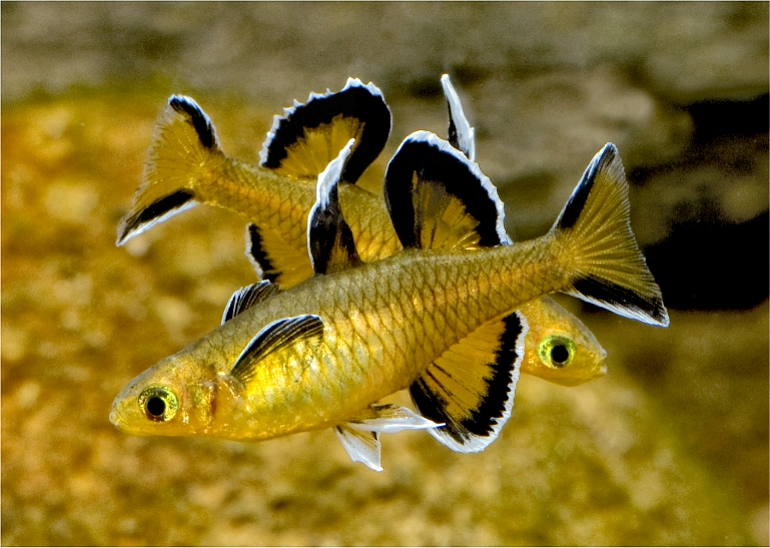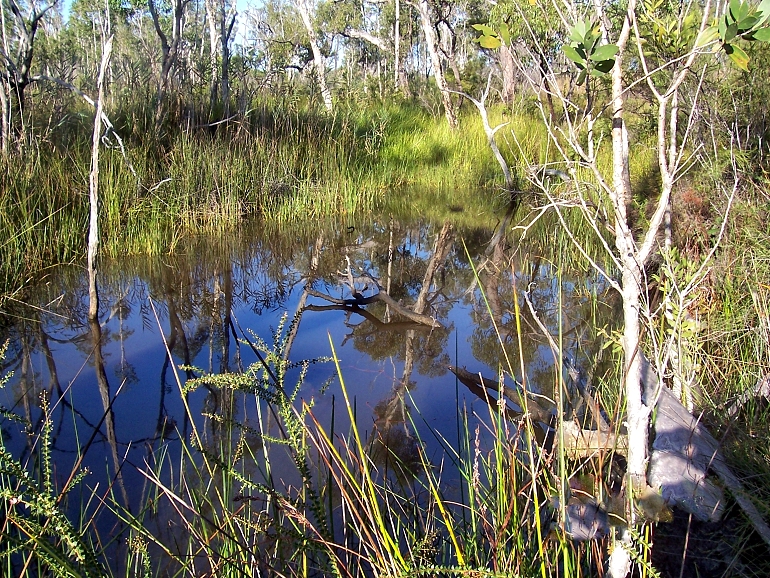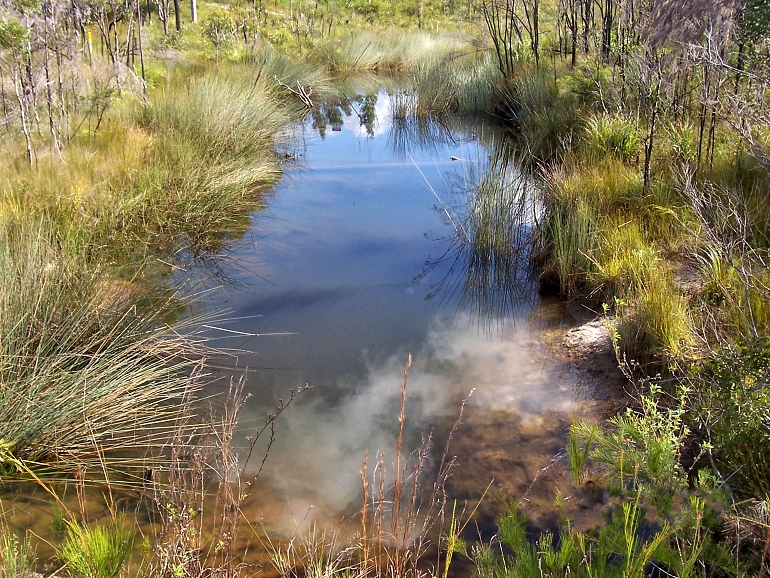|
 |
Pseudomugil mellis - photo© Gunther Schmida |
Allen and Ivantsoff, 1982
Honey Blue-eye
Species Summary
Pseudomugil mellis is a small freshwater species endemic to Australia. They have a moderately compressed and elongated body; usually not exceeding 40 mm, but are more commonly found at lengths between 25 and 30 mm. Males are honey-coloured with the first two rays of the dorsal and anal fins black with creamy-brown centres and outer white margins. The body scales are lightly edged with black forming an attractive latticework pattern. They have two dorsal fins, separated by a small gap, the first much smaller than the second. Males are easily distinguished from females by their brighter colours and longer and more elongated dorsal fins. Females and juveniles have a plain light-amber coloured body with small unmarked translucent fins. Pseudomugil mellis was formally described by Gerald Allen and Walter Ivantsoff in 1982.
 |
Natural habitat of Pseudomugil mellis - photo© Leo O'Reilly |
Distribution & Habitat
Pseudomugil mellis have a patchy and restricted distribution in southern Queensland, extending from about 65 km north of Brisbane to Maryborough, including Fraser Island. The oligotrophic freshwater wetlands of Shoalwater Bay are the northernmost known habitat of Pseudomugil mellis, having been collected at the northern end of Dismal Swamp (Trnski et al. 1993). Although their range has been severely reduced, they are currently known from about 30 locations on both the mainland and Fraser Island. It is still relatively abundant in the Noosa River catchment and Fraser Island localities. Pseudomugil mellis is known to co-occur with Pseudomugil signifer in Lake Wabby and Bool Creek on Fraser Island, and Schnapper Creek and Big Tuan Creek on the mainland. Big Tuan Creek is a small coastal creek about 5 km south from the mouth of the Mary River. Most populations are totally isolated from one another.
The former distribution of P. mellis may well have extended from Woodgate in central Queensland extending southwards to the Myall Lakes, in the northern coast region of New South Wales, including the offshore sand islands. This range has been fragmented by residential development, forestry plantations and agriculture. Most existing locations have been similarly affected by changes within their catchments. While a number of suitable habitat streams still exist in the region between Brisbane and Noosa, it is likely that most will show substantial differences in water chemistry in comparison to similar undisturbed streams. Its abundance within this area has been drastically reduced and it now only occurs as a number of isolated populations where there is suitable remaining habitat. Its continued existence is being threatened by continuing urban development and the spread of the introduced mosquitofish (Gambusia holbrooki).
Pseudomugil mellis are typically found in slightly acidic and tannin-stained water in coastal heathland (wallum) swamps and streams. Wallum is a restricted region and hence any species of fauna confined to it are restricted in their distribution. However, they can also be found in clear water habitats. They inhabit freshwater dune lakes, creeks, swampy areas and wetlands. These waterbodies are characterised by low pH (4.4 to 6.8), and very low dissolved mineral salts. The first time I collected this species from the wild I recorded a water hardness of 10 mg/L CaCO3, pH 5.8, and conductivity 170 µS/cm. They can tolerate wide fluctuations in stream temperature, from 11°C in winter to 38°C in summer. They usually occur where there is little or no flow over sandy or muddy substrates with abundant emergent and submerged aquatic vegetation. The presence of aquatic vegetation appears to be essential for this species for shelter, foraging, spawning and the growth of larvae and fry. They may occur with Rhadinocentrus ornatus, Nannoperca oxleyana, Melanotaenia duboulayi and other small bodied native fishes.
 GS.jpg) |
Pseudomugil mellis (Spawning males with female) - photo© Gunther Schmida |
Reproductive Biology
The reproductive biology of Pseudomugil mellis has been well documented from studies of wild populations and from specimens maintained in captivity. The following summarises much of that information:
In their natural habitat females ready to release eggs have been found from September to January. Spent fish (examination of the ovaries indicates that only a small percentage of eggs are sufficiently developed to the stage at which they are able to be fertilised) have been collected from November to April. The number of spent males and females was found to be highest in January. This indicates that Pseudomugil mellis begin to spawn in the wild as early as September/October and that most members of the population have ceased to spawn by January/February. Spawning in the wild occurs at temperatures in the range of 26-28°C. Females spawn at around 17-22 mm in size with the larger females producing more eggs than smaller females.
The small maturation size and the use of batch spawning over successive days were considered to be reasons for the successful recruitment of this species in the wild. Recruitment is further maximised by several mechanisms that decrease predation: territorial defence of the spawning site by the male, direct pairing with a short courtship, and larvae that swim at the surface and seek cover in the meniscus of floating objects when predators attack.
In captivity, males exhibit territorial behaviour guarding the spawning site from intruding conspecifics. Prespawning behaviour is initiated adjacent to the spawning site by the male raising his fins and swimming in a zigzag pattern to block the female's retreat. Spawning usually occurs in late morning and early afternoon with the female entering the spawning site first, followed by the male. After spawning, the male will continue to display, defending his territory and thus the fertilised eggs. Spawning usually commences at around 10-12 months of age when water temperatures exceed 20°C and the fish are about 20 mm in size. Sexual dimorphism is evident, with adult males having larger and more colourful dorsal and anal fins. Males develop black and white fin marking with a golden bronze sheen to the body when displaying.
Females spawn 1-15 eggs each day for about 7-9 days, with 1 to 4 eggs at a time being released amongst aquatic vegetation or spawning mops. A total of 42-125 eggs can be released over that period. Eggs are demersal, adhesive and attached to aquatic plants or spawning mop. After spawning females rest for 4-9 days, during which time they formed schools. Water hardened eggs range from 1.29-1.64 mm in diameter, probably depending on the size of the female and have adhesive tendrils or filaments to attach them to the spawning site. Eggs hatch 12-14 days (288-336 hours) after fertilisation at a constant water temperature of 24°C. At slightly elevated water temperatures of 25-27°C eggs hatched between 5 and 8 days (112-190 hours). Larvae are around 3.60-5.00 mm SL at hatching and begin feeding at the surface after absorption of the yolk and oil droplets (3-80 hours after hatching). Juveniles feed mid-water or from benthic surfaces.
The secret in maintaining long-term captive populations of Pseudomugil mellis is to constantly breed them. There is a reduction in the frequency and intensity of spawning activity in fish over one year of age. If you fail to notice the change they become too old and then you just lose them. Try to obtain young specimens and breed them early and regularly and you will always have some around to enjoy. Because each female only lays a few eggs each day, it can take a while before you have significant numbers. If possible, start with 6-10 juveniles rather than adults pairs. They are easy to maintain under standard aquarium conditions and will develop on standard commercial fish foods. Mature fish can be easily set up and induced to spawn by manipulation of water temperature and photoperiod throughout the year. When maintained under appropriate aquarium conditions, survival rates above 90% can be attained.
Remarks
Pseudomugil mellis currently has a conservation status listing as vulnerable (Nature Conservation Act 1992 (Queensland): December 2014). You can do your part in helping to preserve this species and their natural habitat by breeding and maintaining captive populations. Collecting wild specimens for the hobby can have a direct impact on their population numbers to the extent that they could become locally extinct. It is becoming increasingly difficult to find them at the popular spots in Tin Can Bay. We know that their populations undergo large fluctuations associated with seasonal recruitment and if they are over-collected during a period of low population numbers, they may never recover and we could well see them disappear from that location. Habitat destruction or alteration in some areas has also favoured the spread of the aquatic terrorist, Gambusia holbrooki.
 |
Natural habitat of Pseudomugil mellis - photo© Leo O'Reilly |
Literature
Allen G.R. & W. Ivantsoff (1982) Pseudomugil mellis, Le Honey Blue-eye, une nouvelle espece de Poisson Arc-en-ciel (Melanotaeniidae) d'Australie orientale. Revue francaise Aquariologie 9(3): 83-86.
Allen G.R. (1989) Freshwater fishes of Australia. T.F.H. Publications, Inc., Neptune City, New Jersey.
Arthington A.H. & C.J. Marshall (1993) Volume 1: Distribution, ecology and conservation of the Honey Blue-eye, Pseudomugil mellis, in south-eastern Queensland. Final Report to the Australian Nature Conservation Agency, Canberra. 100 pp.
Arthington A.H. & C.J. Marshall (1995) Threatened fishes of the world: Pseudomugil mellis Allen & Ivantsoff, 1982 (Pseudomugilidae). Environmental Biology of Fishes 43: 268.
Burnett Mary Natural Resource Management Plan (2005) Country to Coast - A Healthy Sustainable Future. Burnett Mary Regional Group.
Merrick J.R. & G.E. Schmida (1984) Australian freshwater fishes: biology and management. Griffin Press Ltd., South Australia.
Saeed B., W. Ivantsoff and G.R. Allen (1989) Taxonomic revision of the family Pseudomugilidae (Order Atheriniformes). Australian Journal of Marine and Freshwater Research 40: 719-787.
Semple G.P. (1991) Reproductive Behaviour and early Development of the Honey Blue-eye, Pseudomugil mellis Allen and Ivantsoff 1982 (Pisces: Pseudomugilidae), from the North-east Coast Division, South-eastern Queensland, Australia. Australian Journal of Marine and Freshwater Research 42: 277-286.
Tappin A.R. (1984) In search of the Honey Blue eye, Pseudomugil mellis. Fishes of Sahul 1(4): 37-39.
Trnski T., D.J. Bray, J.M. Leis, M.A. McGrouther and S.E. Reader (1993) Survey of Fishes of Shoalwater Bay Training Area, Queensland.
Wager R. & P. Jackson (1993) The Action Plan for Australian Freshwater Fishes. Australian Nature Conservation Agency, Canberra.
Adrian R. Tappin
Updated August, 2015



|

